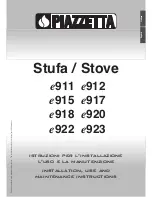
26
onds. In addition, if you intend to put additional fuel into the fire, before the
opening of the door only there may be only ember bed in the burning space, i.e.
no flames may be visible.
Led into the burning space in correspondence with the existing conditions, the secon-
dary air provides for the follow-up burning of the combustible components of in the
burning space. This in fact means smoke and soot-poor burning, which contributes to
the protection of the environment. If you wish to commission the fireplace in a transi-
tional period, please, please first examine the chimney draught, as it can be especially
weak at high external temperatures. Towards this end, hold a burning match in the
slightly opened feeding door. If the flame is not drawn significantly by the draught,
then a so-called starting fire is to be set first. Towards this end, burn wood chips/wool
in the fireplace or the cleaning hole of the chimney. The fire grate is to be cleaned
before every kindling to ensure the proper inflow of air for burning. The ashtray is to
be emptied regularly (picture 5). Should the equipment be extremely hot, use the
gloves provided. Please, be careful not to dispose glowing materials into the waste
bin.
Ensure that the ashtray should be fully pushed into the equipment.
Warning! In order to keep the air clean and safeguard the fireplace, do not ex-
ceed the specified maximum fuel quantity, otherwise overheating may occur,
which potentially damage the equipment. Such damage is not covered with any
guarantee. Only a single layer of fuel is allowable to be prepared in the fireplace.
Try to reach lower heating performance only by decreasing the quantity of fuel,
and not by cutting the primary air supply.
1.5 Cleaning and maintenance
After the heating season, it is recommended to clean the fireplace and the flue gas
pipes carefully. Any dropping heating performance is almost always the consequence
of the strong contamination of the flues. For cleaning, the baffle plate (picture 6 No. 2)
is to be pulled forward. This way, the flues can be cleaned from the inside or – after
removing the flue gas pipe – from above. After cleaning, the baffle plate (picture 6 No.
2) is be pushed back fully again.
Warning!
Following every heating season you are advised to examine the fireplace thoroughly.
If any repair or reconditioning is needed, please, contact your local dealer in a timely
manner, and specify the model number and serial number of your equipment (as seen
on the model plate). External surfaces may be maintained only after the fireplace
cooled down, and following the first commissioning. Use cold water for cleaning, or
soap, washing ingredient in extraordinary cases, then wipe it dry. Before its first use,
clean the ROBAX inspection glass with a wet and clean cloth, and then put a few
drops of glass–ceramics cleaner onto both sides of the glass, and spread them with
the use of kitchen paper tissues. It provides an invisible film on the valuable surface of
the Robax glass. This film helps to keep the glass clean, and facilitates regular clean-
ing operations. ROBAX S for slightly contaminated surfaces – a commercially avail-
able glass surface cleaning agent – may as well be used for the cleaning of the me-
dium or strongly contaminated glass surfaces of the fireplace. Towards this end, spray
Содержание LINZ 108 49
Страница 11: ...11 Transportsicherung Kartonpapier entfernen 2 Bild 6...
Страница 18: ...18...
Страница 19: ...19...
Страница 28: ...28 Protection corrugated paper for transportation picture 6 2...
Страница 44: ...44 Fig 6 l ment retirer avant la mise en service 2...
Страница 60: ...60 Fig 4 Fig 5 Rimuovere carta ondulata di imballaggio Fig 6 2...
Страница 82: ...3 M szaki adatok 3 1 M retrajz TYP 108 49 LINZ THYRA...
















































